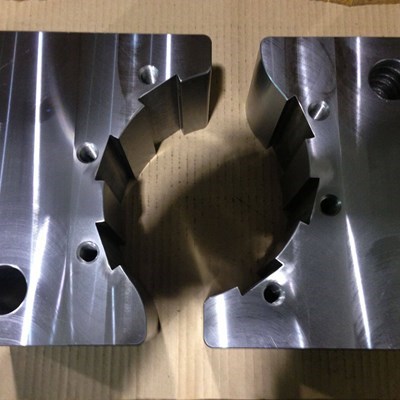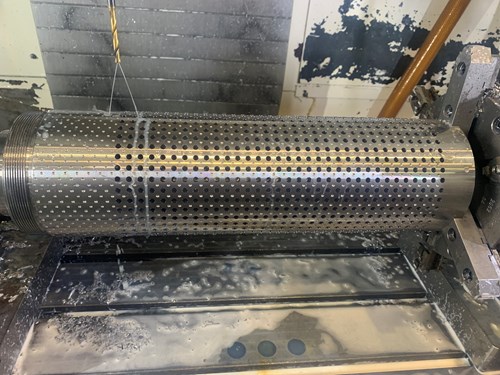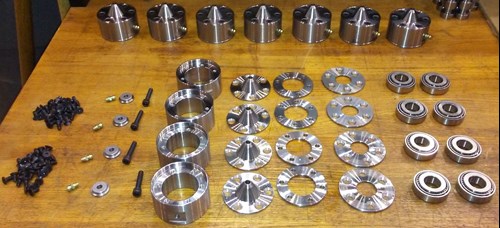CNC Milling
Our machine shop specializes in precision-turned product machining and features a number of vertical milling machines outfitted with the latest industry features that you'd expect from a state-of-the-art facility. Our team of dedicated operators have an intimate knowledge of CNC milling operations and are committed to our standard of quality that has served as the foundation of our business for three generations.
Our 3-axis milling machines serve as an effective solution for any and all components that don't require multi-side detailing or complex geometric cutting. Whether you need a single prototyped part or dozens of pieces with a high degree of accuracy and repeatability, get in touch with us by requesting a quote right here on our website.
Click here for a downloadable version of our equipment capabilities.
Find out more about our machining division:
CNC Milling and Machining: Definition and Historical Overview
CNC (Computer Numerical Control) machining is a subtractive manufacturing technology by which production machine movements are dictated by a set of pre-programmed code. CNC milling machines use cutting tools that typically rotate at thousands of RPMs on 3 or 5 axes to make cuts into a block of material (often called the workpiece) with great accuracy. These CNC machines control a wide range of complex parts, such as grinders, lathes, and turning mills, all of which are implemented to cut and shape anything from single prototyped parts to dozens of thousands of uniform pieces. CNC machinists often specialize in mathematics, computer programming, and mechanical design to aid in the production of a wide range of composite materials, such as wood, plastics, and exotic metals.
Before the proliferation of computers in the 1960s, most numerical control machines in the 1940s and 1950s required an operator to manually input machining instructions via magnetic tape or punched cards. Physical repositioning of the workpiece by the machinist was frequently necessary, leading to comparatively lower accuracy cuts, higher material waste, and slower production turnaround times. The advent of the use of computers (thereby introducing the ‘C’ in ‘CNC’) in manufacturing largely eliminated these downsides, and by the 1970s a machining program known as G-code was universally used to automate precise machining tool movements.
Since the turn of the 21st century, contemporary CNC milling and machining has radically revolutionized manufacturing and production. Coupled with relatively new advancements in additive technology (such as 3D printing), modern production machines are capable of producing parts with specifications from ±0.0002” (±0.00508 mm) to ±0.0005” (±0.0127 mm) at scale. Most CNC milling machines now feature a myriad of advanced capabilities, and machined parts are ubiquitous with nearly every industrial sector today, with particular prevalence in automotive, aerospace, and petrochemical sectors.


CNC Milling and Machining: Setup and Processes
Designing and Programing
The first step in 3-axis CNC milling is to create a detailed design of the desired part using computer-aided design (CAD) software. Once the design is finalized, the next step is to program the milling machine with the necessary instructions to produce the part accurately. This is typically done using computer-aided manufacturing (CAM) software, which generates the toolpaths and commands needed for the milling machines.
Material Preparation
The workpiece material, such as metal, plastic, or wood, is prepared by securing it to the milling machine's worktable using clamps or fixtures. The workpiece must be properly aligned and securely held in place to ensure accurate milling.
Tool Selection and Setup
The appropriate milling tools are selected based on the material and desired machining operations. The tools are inserted into the tool holder and securely mounted in the machine's spindle. The tool setup also involves setting the tool length and diameter offsets, ensuring that the milling machine has accurate measurements for precise machining.
Machine Setup
The CNC milling machine is prepared for the milling process by setting the cutting speeds, feed rates, and depth of cut. These parameters are determined based on the material being machined, the cutting tool being used, and the desired surface finish and cutting efficiency. The machine's coordinate system is also established to define the reference point for the machining operations.
Machining Operations
Once the machine setup is complete, the milling process begins. The CNC milling machine follows the programmed toolpaths and commands to perform the cutting operations. The three axes—X, Y, and Z—are controlled simultaneously to move the cutting tool in a specific pattern, removing material from the workpiece to shape it according to the design.
Tool Changes and Maintenance
If the milling process requires multiple tools or different cutting operations, tool changes may be necessary. The CNC milling machine automatically changes the tools as programmed, ensuring a smooth transition between operations. Additionally, regular tool maintenance, such as cleaning or replacing worn tools, is performed to maintain the machining quality and accuracy.
Finishing and Inspection
Once the milling operations are completed, the part may undergo additional finishing processes such as deburring or surface smoothing to achieve the desired surface quality. The finished part is then inspected for dimensional accuracy and adherence to the design specifications using measurement tools such as calipers or coordinate measuring machines (CMM).
CNC Milling and Machining: Design Restrictions and Solutions
When it comes to CNC milling and machining (especially when restricted to 3-axis CNC machining), there are certain design restrictions that need to be considered to ensure successful manufacturing. The following are some common design restrictions and potential solutions for CNC milling and machining:
Undercuts and Overhangs
3-axis machining is limited in its ability to access deep undercuts and overhangs due to the fixed tool orientation. These features may require additional setups or alternative machining methods. Solutions include incorporating draft angles to facilitate part removal or utilizing secondary operations such as manual machining or EDM (electrical discharge machining) for intricate features.
Wall Thickness
Thin and delicate walls can pose challenges in 3-axis machining, as they may be prone to vibration, deflection, or distortion. Design solutions involve increasing wall thicknesses to enhance structural integrity or incorporating support structures or ribs to reinforce thin sections.
Corner Radii
Sharp internal or external corners can be difficult to machine accurately with 3-axis milling. It is advisable to incorporate fillets or radii in such corners to facilitate tool access and reduce stress concentrations. Larger radii are easier to machine, provide smoother transitions, and enhance part strength.
Tool Access and Interference
Complex geometries with tight spaces or deep pockets may restrict tool access and cause interference with the CNC milling equipment. Designing parts with proper clearance and providing sufficient tool access paths can help avoid such issues. This may involve adjusting part orientation, incorporating relief cuts, or using specialized tooling, such as long-reach tools or smaller diameter cutters.
Part Size and Fixturing
The physical size of the part and the available work envelope of the CNC machine can limit the machining options. Design considerations include breaking down larger parts into multiple components that can be machined separately and then assembled. Additionally, designing efficient and secure fixturing solutions is crucial to ensure stable workpiece positioning and minimize part movement during machining.
Tolerance and Surface Finishing
Achieving tight tolerances and high-quality surface finishes can be challenging with 3-axis machining, particularly on complex surfaces. Designers should account for the limitations of the process and specify achievable tolerances based on the material, tooling, and machine capabilities. If tighter tolerances or smoother finishes are required, secondary operations like grinding or polishing may be necessary.
Materials Selection
The choice of material can impact the feasibility and machining complexity in 3-axis CNC machining. Softer materials like plastics or non-ferrous metals are generally easier to machine, while harder materials like stainless steel or titanium may require specialized tooling or machining strategies. Selecting materials with suitable machinability characteristics can optimize the manufacturing process.
It is important for designers to collaborate closely with CNC programmers and machinists to understand the capabilities and limitations of the specific CNC milling machine being used. By considering these design restrictions and exploring appropriate solutions, designers can ensure that their parts can be successfully manufactured using 3-axis CNC machining techniques.



